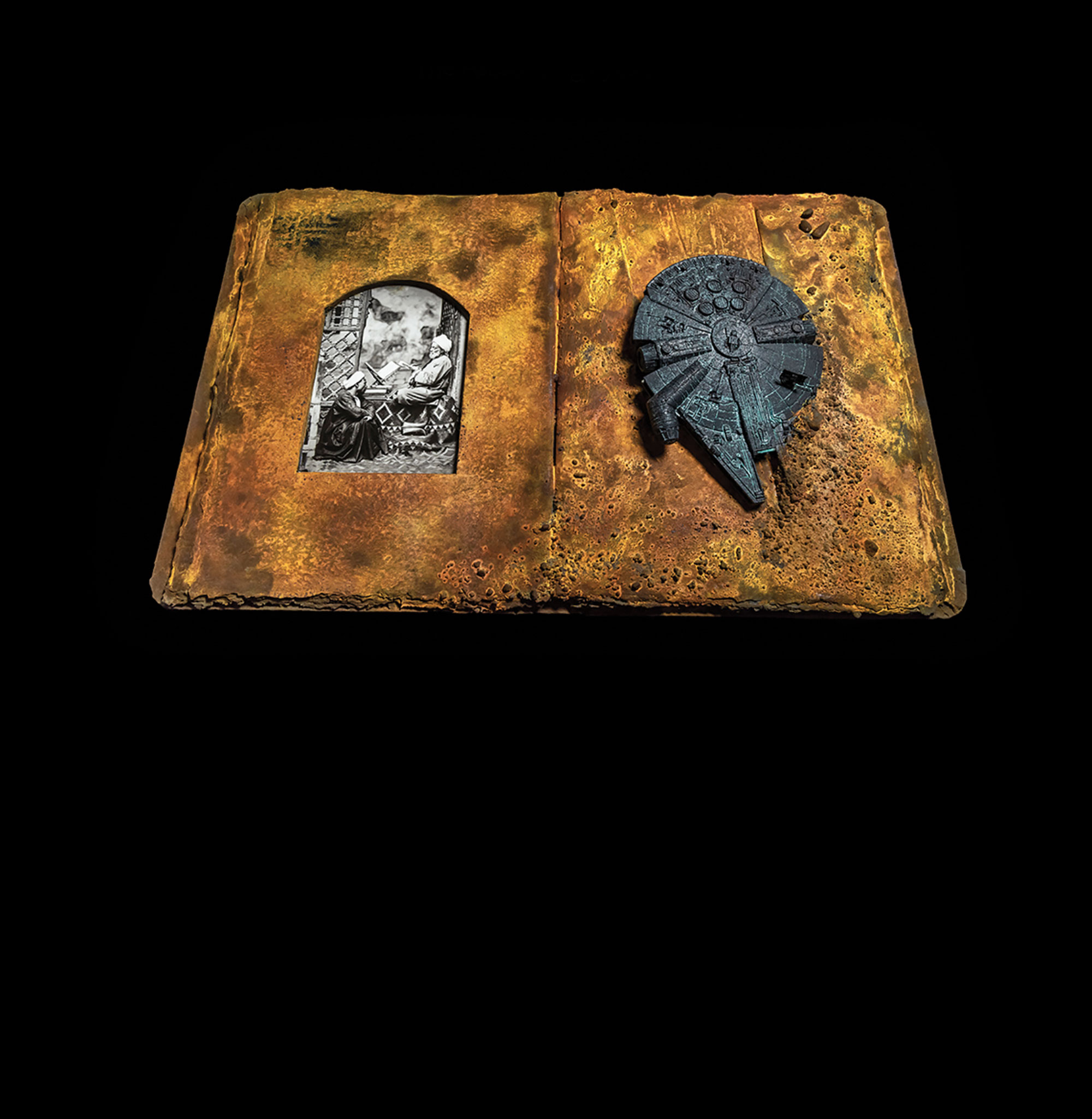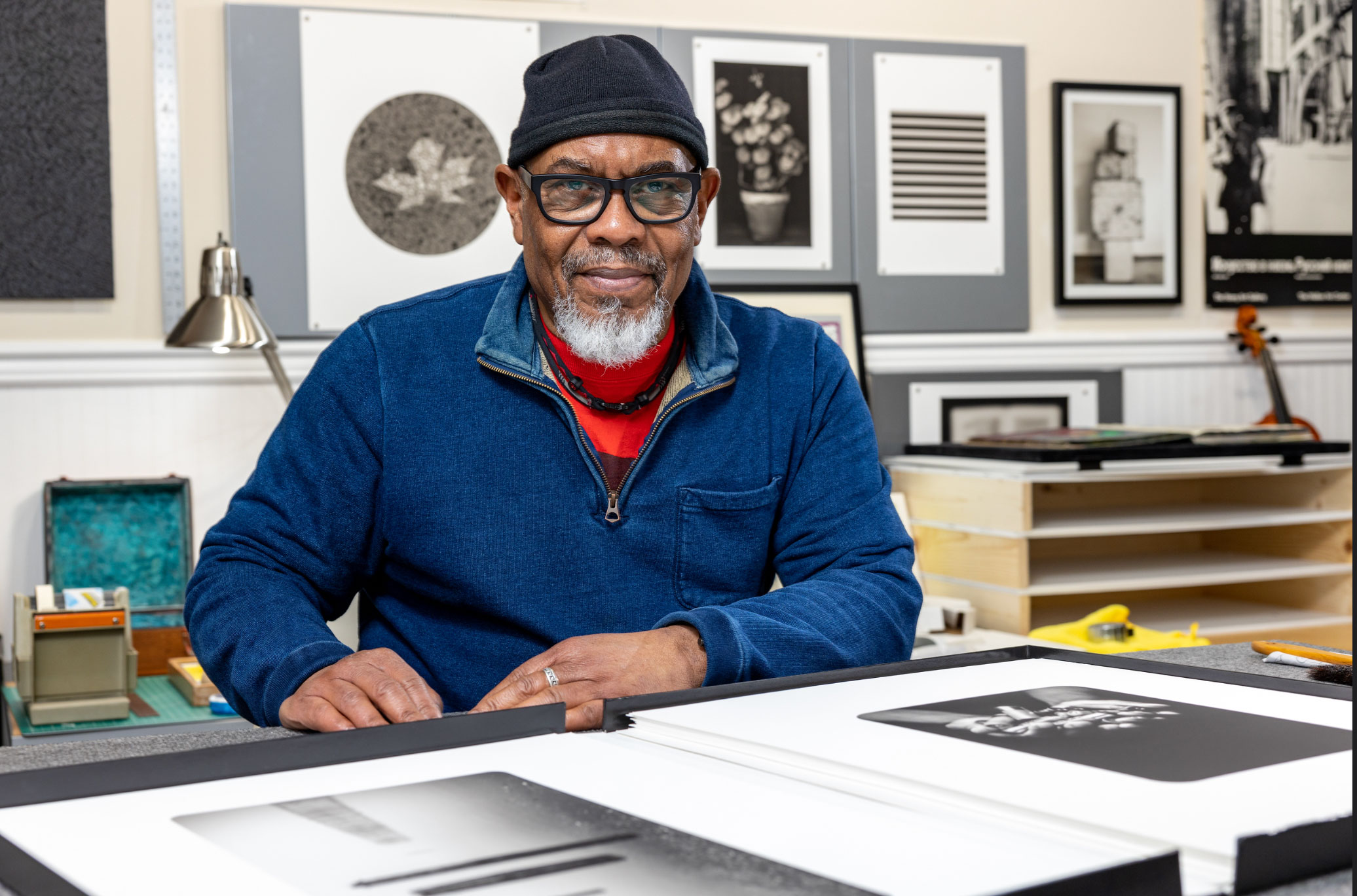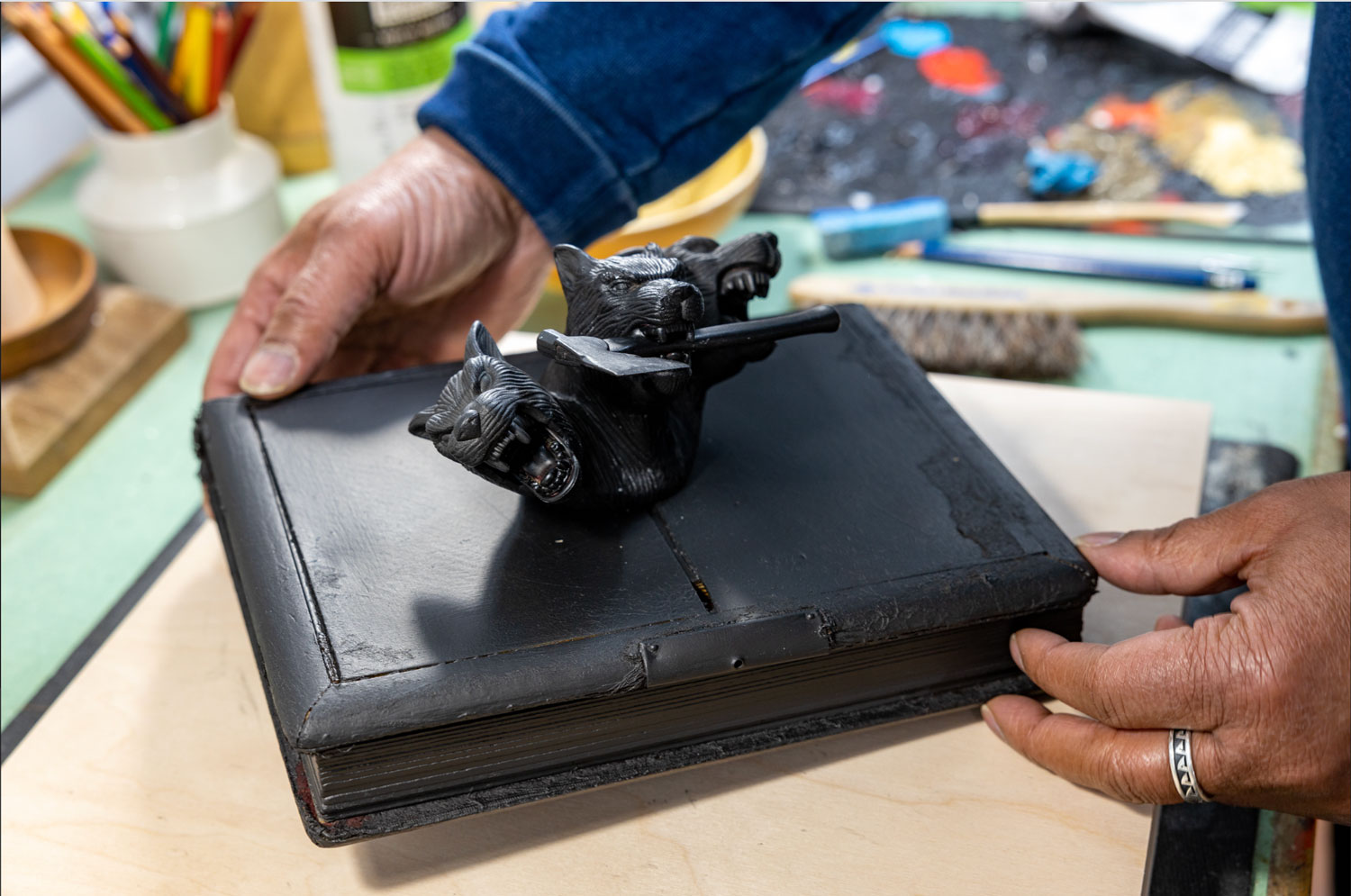Not quite by the book Not quite by the book Not quite by the book
In his new Bellevue exhibition, Preston Wadley renders new truths from old objects.

In his new Bellevue exhibition, Preston Wadley renders new truths from old objects.
For the past few years, Preston Wadley has been thinking about those people who visit a museum or gallery and spend—at most—15 seconds looking at a work of art. How could he keep them longer, he wondered. How could he change their views? His answer to that question is now on display at the Bellevue Arts Museum in an exhibition titled “Abstract Truth.”
Playing on themes that include code switching, colonialism and Black community, Wadley, ’75, ’77, bases his latest sculptures on books that he has opened and rusticated to look like aging iron and copper. It is both a book and not a book, he notes. On the pages, he pairs vintage black and white photos with intriguing found objects like an abacus, a large fishhook or a model Millennium Falcon. Finally, he titles them with words like “The Astounding Eyes of Rita,” “Pelotero” and “The Most Dangerous Man in America,” nudging the viewer into another dimension of understanding.
The works look like they were rescued from a sea floor or forgotten in an attic. While compelling, they are both familiar and strange. Wadley wants to disorient you.
“All objects are something, but they’re also something else,” he says. “That something else is dependent on your life experience.” He wants these works to help visitors realize that their personal truth can be different than others’. He is also seeking to normalize the Black experience by bringing it forward and showing it in new context.

During the months of COVID-19 isolation and with the time afforded by retirement, Wadley has spent more hours exploring and experimenting with his art. Here he looks through a collection of black-and-white photographs he made in empty city parks. Photo by Matt Hagen.
Wadley’s opus is BAM’s first exhibition for 2023, and the show’s grand opening was the museum’s first public event in three years. Here in the wake of a turnover in the museum’s leadership and efforts to invest more deeply in diversity, equity and inclusion work, Wadley’s alluring and insightful works may help further the museum’s goals.
Wadley was born in Los Angeles and describes coming of age at a time of creative innovation and political activism. Vietnam, feminism and the civil rights movements were unfolding around him. Grappling with the news and events like the assassinations of Martin Luther King Jr. and Robert Kennedy, the LA artists and musicians were using their talents to draw attention to the causes. “Everybody I hung out with was looking for some way to contribute to the effort,” he says. Under that influence, he shaped his approach. “My work sort of skates around the edges of folk art, assemblage and sculpture,” he says. “All that stuff was prevalent around Los Angeles at that time.”
Wadley also noted that many significant events and people—like the 1968 Olympic athletes who gave the Black Power salute during the awards ceremony—were tied to the area’s colleges and universities. He also saw activists from higher education like Angela Davis and Maulana Karenga, who created Kwanzaa. As Wadley started exploring the world as an artist and photographer, the activism of the day convinced him that a college or university campus would be a good place to grow.
Wadley found his path to the UW after a conversation with Charles White, an artist celebrated for his powerful images of African Americans who strongly believed that art should further social good. Their talk turned to Jacob Lawrence, another Black artist and teacher of national renown. White said to Wadley, ‘you should go study with him,’ and noted that Lawrence was on the faculty at the University of Washington. “I looked at the school with the largest art department west of the Mississippi, and it had Jacob Lawrence,” Wadley says. “I figured I couldn’t go wrong.”
Wadley arrived in Seattle in the early 1970s. “It was a really rich time,” he says. His teachers included nationally recognized artists Lawrence, Mike Spafford and Patti Warashina. “The bonus was this group of really talented students who all descended on the university at the same time,” he says. Among them, Michael Lucero, Mary Ann Peters, Barbara Earl Thomas, Sherry Markovitz, David Kane and Art Wolfe, who have gone on to become big names in the Northwest art scene. The students were learning from each other, says Wadley. “We had this just wonderfully rich and engaging and peer-led and peer-motivated group of students who learned a lot through osmosis, through each other,” he says. “We didn’t need anybody to tell us we needed to make stuff. We had 24-hour access to this wonderful facility, so we were just in this creative nirvana.”
Classmate Gene Gentry McMahon, ’78, remembers how the students playfully pushed each other to try new things. “We’d go into each other’s studios and tell each other what to do,” she says. “Were we mimicking our faculty? I don’t know. But we did it for real. It was totally silly, but it was great fun.”

Preston Wadley shows a reconstructed book in his studio. His exhibition “Abstract Truth” runs through October 8 at Bellevue Arts Museum. Photo by Matt Hagen.
After completing his master of fine arts, Wadley took a job with Children’s Hospital as a scientific photographer. While it wasn’t as inventive as his fine arts work, it was work he found both technically demanding and meaningful, he says. His 10 years of clinical and surgery photography was an important contribution to teaching and research. He also taught scientific photography at Bellevue Community College. Still, he missed his creative work.
When Gentry McMahon invited him to take over her drawing classes at BCC while she was on sabbatical, Wadley gave himself over to teaching and creating art full time.
In this new capacity, he helped shape and influence new generations of Northwest artists. In the mid-1990s, he joined the faculty at the Cornish College of the Arts. He loved teaching, he says, but more so, he loved enabling his students in their creative pursuits. The students appreciated how invested he was in their work and how knowledgeable he was about different forms of art. He encouraged them to pursue their own projects instead of just completing assignments.
These days, as a professor emeritus, Wadley spends much of his creative time in his studio, an old portable classroom from Nathan Hale High School that was long ago craned into his back yard. Inside, tall south-facing windows bring in light from the early spring sun. One morning this spring, jazz was playing softly on the radio while Wadley set out a recent project, a series of landscape photographs that he took in parks around Seattle in the social-distancing days of the COVID-19 outbreak. Their quiet beauty, made more solemn by the blacks, whites and warm grays in the image, showed the city as both stoic and wild. Retirement and the isolation freed him up to be even more creative. That’s why, when the Bellevue Art Museum came calling, he was ready to develop and curate the current show. In addition to his book sculptures, several of which are on loan from private collections, he has included a series of black-and-white portraits produced over the last decade. Now his friends and fans are celebrating a chance to see what Wadley has been up to lately. “I loved his show,” says Gentry McMahon. “The degree of craftsmanship is breathtaking, really.”
While represented by two galleries and one who often showed his work in faculty shows at Cornish or as part of ensemble exhibits around the Northwest, a full show like this one is a treasure, and a treat.